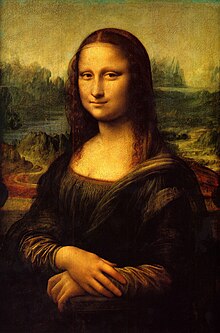利用者:D.h/美術/美術の記事
これは作業用のページです。ウィキペディアの記事は、美術、視覚芸術を参照してください。
- Translation from en:Visual arts 2007-06-11T20:16:18. By Merphant, Visual arts, Rasmus Faber, Clubmarx, Brunberg, et al.
For the public high school in Baltimore, Maryland see: Augusta Fells Savage Institute of Visual Arts

The visual arts are art forms that focus on the creation of works which are primarily visual in nature, such as painting, photography, printmaking, and filmmaking. Those that involve three-dimensional objects, such as sculpture and architecture, are called plastic arts. Many artistic disciplines (performing arts, language arts, and culinary arts) involve aspects of the visual arts as well as other types, so these definitions are not strict.
The current usage of the term "visual arts" includes fine arts as well as crafts, but this was not always the case. Before the Arts and Crafts movement in Britain and elsewhere at the turn of the 20th century, "visual artist" referred to a person working in the fine arts (such as painting, sculpture, or printmaking) and not the handicraft, craft, or applied art disciplines. The distinction was emphasized by artists of the Arts and Crafts movement who valued vernacular art forms as much as high forms. The movement contrasted with modernists who sought to withhold the high arts from the masses by keeping them esoteric.[要出典] Art schools made a distinction between the fine arts and the crafts in such a way that a craftsperson could not be considered a practitioner of art.
In colloquial speech, fine art is sometimes referred to as capital "A" art, or art with a capital "A."
ドローイング
[編集]en:Drawing is a means of making an image, using any of a wide variety of tools and techniques. It generally involves making marks on a surface by applying pressure from a tool, or moving a tool across a surface. Common tools are graphite pencils, pen and ink, inked brushes, wax color pencils, crayons, charcoals, pastels, and markers. Digital tools which simulate the effects of these are also used. The main techniques used in drawing are: line drawing, hatching, crosshatching, random hatching, scribbling, stippling, and blending. An artist who excels in drawing is referred to as a draftsman or draughtsman".
絵画
[編集]Painting taken literally is the practice of applying pigment suspended in a carrier (or medium) and a binding agent (a glue) to a surface (support) such as paper, canvas or a wall. However, when used in an artistic sense it means the use of this activity in combination with drawing, composition and other aesthetic considerations in order to manifest the expressive and conceptual intention of the practitioner. Painting is also used to express spiritual motifs and ideas; sites of this kind of painting range from artwork depicting mythological figures on pottery to The Sistine Chapel to the human body itself.
版画
[編集]Printmaking is creating for artistic purposes an image on a matrix which is then transferred to a two-dimensional (flat) surface by means of ink (or another form of pigmentation). Except in the case of a monotype, the same matrix can be used to produce many examples of the print. Historically, the major techniques (also called mediums) involved are woodcut, line engraving, etching, lithography, and screenprinting (serigraphy, silkscreening) but there are many others, including modern digital techniques. Normally the surface upon which the print is printed is paper, but there are exceptions, from cloth and vellum to modern materials. Prints in the Western tradition produced before about 1830 are known as old master prints. There are other major printmaking traditions, especially that of Japan (ukiyo-e).
写真
[編集]Photography is the process of making pictures by means of the action of light. Light patterns reflected or emitted from objects are recorded onto a sensitive medium or storage chip through a timed exposure. The process is done through mechanical, chemical or digital devices known as cameras.
The word comes from the Greek words φως phos ("light"), and γραφις graphis ("stylus", "paintbrush") or γραφη graphê, together meaning "drawing with light" or "representation by means of lines" or "drawing." Traditionally, the product of photography has been called a photograph. The term photo is an abbreviation; many people also call them pictures. In digital photography, the term image has begun to replace photograph. (The term image is traditional in geometric optics.)
コンピュータアート
[編集]Visual artists are no longer limited to traditional art media. Computers may enhance visual art from ease of rendering or capturing, to editing, to exploring multiple compositions, to printing (including 3D printing.)
Computer usage has blurred the distinctions between illustrators, photographers, photo editors, 3-D modelers, and handicraft artists. Sophisticated rendering and editing software has led to multi-skilled image developers. Photographers may become digital artists. Illustrators may become animators. Handicraft may be computer-aided or use computer generated imagery as a template. Computer clip art usage has also made the clear distinction between visual arts and page layout less obvious due to the easy access and editing of clip art in the process of paginating a document, especially to the unskilled observer.
造形芸術
[編集]- 工芸
- 造形 造形芸術 フィギュア en:Plastic arts
- 建築
- 窯業 陶芸 Ceramics
- ランド・アート
- 金属工芸 金属加工 Category:金属加工 en:Metalworking en:Category:Metalworking
- モザイク
- Category:紙細工 en:Category:Paper art
- 彫刻
- 織物 テキスタイル en:Textile art
- 木工 en:Woodworking
- ガラス ガラス工芸 en:Glass - en:Glass art
美術関連の用語
[編集]参考
[編集]- Carey, John (1992). The Intellectuals and the Masses. Faber & Faber. ISBN 0-571-16926-0
関連項目
[編集]- 美術の主要記事 en:List of basic visual arts topics
- 美術史 en:History of art
- 映画史 en:History of film
- 絵画の歴史 en:History of painting
- 彫刻の歴史 en:History of sculpture
- 造形芸術 en:Plastic arts
- 写真史 - 世界写真史 - 日本写真史
外部リンク
[編集]- AHDS Visual Arts - digital resources for the visual arts
- ArtLex - online dictionary of visual art terms.
- Art History Timeline by the Metropolitan Museum of Art.
- Tenability of the Distinction Between Arts and Crafts - essay. (PDF)
